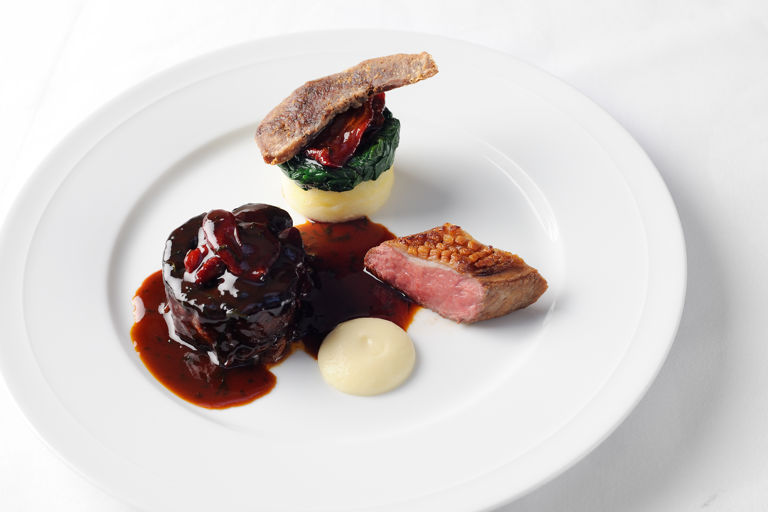Assiette of lamb with garlic purée
Item 1 of 1
- 8
- 5 hours 30 minutes
This challenging assiette of Lune Valley lamb recipe from William Drabble's features the sadly underused lamb's tongue. Order in advance from a good butcher and you'll be hooked on the surprisingly mild and tender meat. Deep fried with a simple coating of seasoned flour, the tongue provides some textural contrast to the soft braised lamb's neck and tender roasted loin. Save time on the day by cooking the lamb neck a day ahead.
First published in 2015
discover more:
Ingredients
Metric
Imperial
Lamb
- 1 loin of Lune Valley lamb, off the bone with skin removed and fat scored
- 1 middle neck of Lune Valley lamb, on the bone
- 4 tbsp of olive oil
- 1 onion, chopped
- 2 carrots, chopped
- 2 celery sticks, chopped
- 1 leek, chopped
- 6 garlic cloves, chopped
- 3 sprigs of fresh rosemary
- 1 tbsp of tomato purée
- 3l chicken stock
- 1 knob of butter
Lamb's tongues
- 2 lamb's tongues
- 1/4 onion, chopped
- 1/2 carrot, chopped
- 1/2 celery stick, chopped
- 1/4 leek, chopped
- 2 garlic cloves, chopped
- flour, seasoned
- vegetable oil
- 1 tsp salt
Garlic purée
- 4 bulbs of garlic
- 300ml of double cream
- 1 sprig of fresh rosemary
- salt
- pepper
To plate
- 1 handful of spinach leaves
SAVE RECIPE
Equipment
- Fine sieve
- Deep fat fryer
- Liquidiser
Method
1
Start by preparing the lamb. Remove the loin from the bone, remove the skin, then score the fat and set aside. Alternatively, ask your butcher to prepare the lamb for you
2
Put 2 tablespoons of the oil into a casserole pan large enough to hold the whole middle neck. Caramelize the neck all over and put to one side
- 1 middle neck of Lune Valley lamb
- 2 tbsp of olive oil
3
Add another tablespoon of olive oil and add the carrot, onions, celery, leek, garlic and rosemary and cook slowly until the vegetables start to caramelize
- 1 onion
- 2 carrots
- 2 celery sticks
- 1 leek
- 6 garlic cloves
- 3 sprigs of fresh rosemary
- 1 tbsp of olive oil
4
Add the tomato purée and cook for a few minutes, stirring constantly until it darkens slightly. Add the chicken stock, return the lamb neck to the pan and bring to the boil
- 1 tbsp of tomato purée
- 3l chicken stock
5
Cover with a tight fitting lid and cook in the oven at 120°C/Gas mark 1/2 for 3-4 hours. You will be able to tell when the lamb is cooked as it will just fall off the bone
6
To make the garlic purée, peel the garlic and place into a big pan of lightly salted water, bring to the boil and cook until soft. Drain and return to a clean pan
7
Add the double cream, rosemary and a little seasoning, bring to a gentle boil and reduce until the cream starts to thicken. Be careful as the mixture will burn easily. Remove the rosemary sprig, liquidise, pass through a fine sieve and set aside
- 300ml of double cream
- 1 sprig of fresh rosemary
- salt
- pepper
8
When the neck is tender and cooked through, remove from the liquid and put to one side. Strain the braising liquid through a fine sieve into a pan and leave to settle
9
Remove the fat from the sauce with a ladle and reduce over a medium-high heat to sauce consistency and set aside
10
Remove the bones from the middle neck. Roll the meat into a long sausage shape in cling film and refrigerate until firm for at least one hour (preferably overnight)
11
Place the lamb tongues into a pan of cold water and bring to the boil, then place the pan into the sink and run cold water over the tongues to wash away any impurities
12
Put the tongues into a clean pan and cover in cold water. Add the onion, carrot, celery, leek, garlic and salt and bring slowly up to the boil
- 1/4 onion
- 1/2 carrot
- 1/2 celery stick
- 1/4 leek
- 2 garlic cloves
- 1 tsp salt
13
Reduce the heat and simmer for 1-1½ hours or until the skin peels off the tongues easily. When tongues are cooked, peel off the skins and refrigerate. Once cooled, cut each tongue into four lengthways and set aside
14
To cook the loin, slowly crisp the fat side in a frying pan in 1 tablespoon of olive oil. Turn the loin to seal it all over, then put into an oven fat-side down and cook at 170°C/gas mark 3 for 3-5 minutes until medium-rare
- 1 tbsp of olive oil
15
Remove from the oven and rest
16
To reheat the middle neck, carve into 2.5cm-thick slices, remove the cling film and place into a shallow sided pan. Add a little of the reduced lamb jus and a knob of butter
- 1 knob of butter
17
Bring to boil then place into the oven at 160°C/gas mark 2. Keep basting the meat with the sauce until glazed
18
Coat the tongues in a little seasoned flour and deep-fry until crisp. Remove and season with salt and pepper
- flour
- vegetable oil
19
To serve, place some cooked spinach onto each plate and then a piece of tongue
- 1 handful of spinach leaves
20
Slice the loin and arrange two slices neatly on the plate. Put the glazed lamb neck next to that then the garlic purée between each pile. Pour lamb jus over the neck and let it disperse around the plate
Get in touch
Please sign in or register to send a comment to Great British Chefs.



